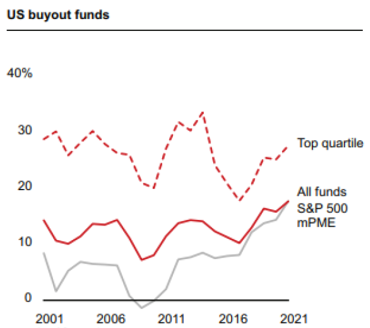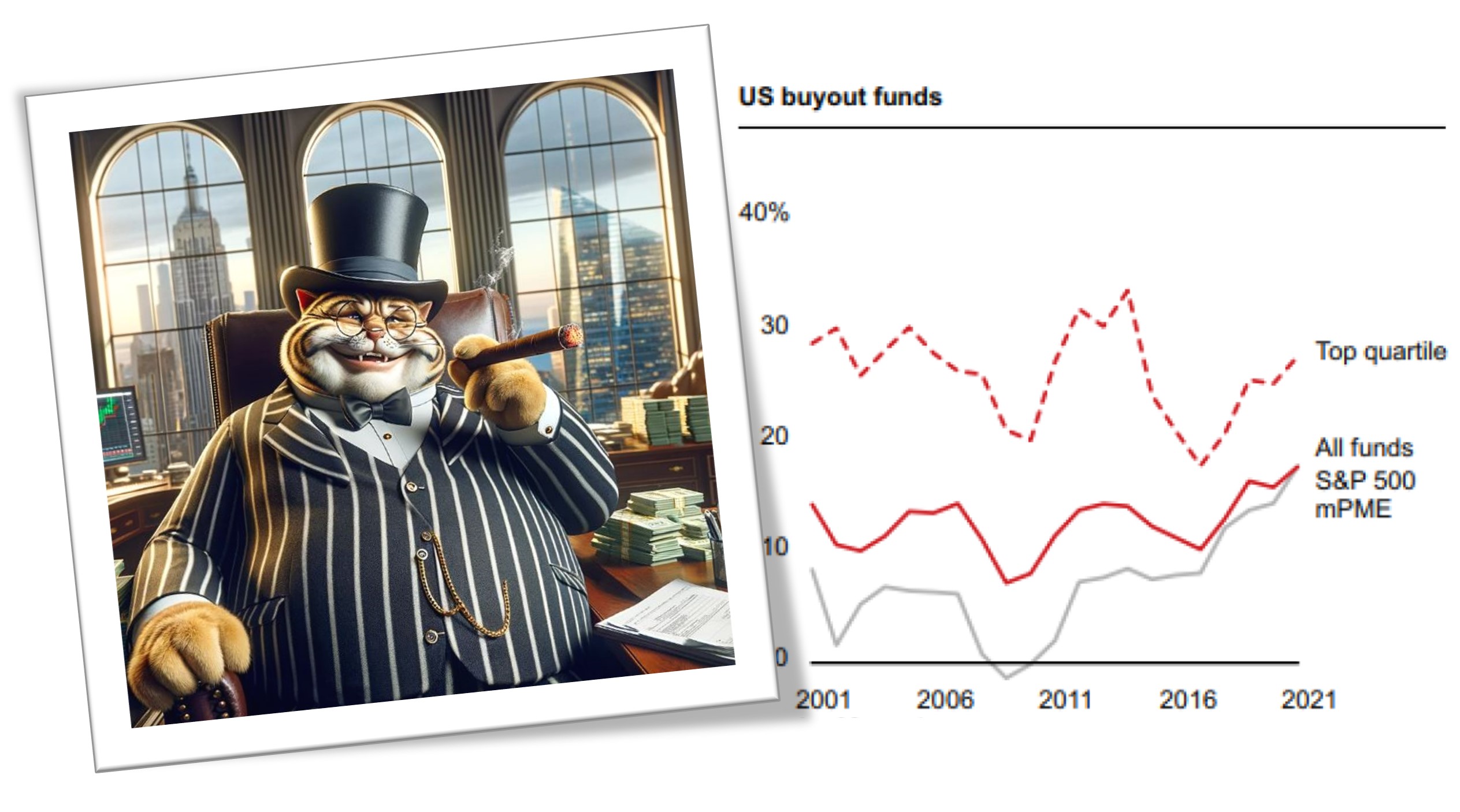In recent years, Private Equity (PE) has emerged as a highly popular investment alternative for wealthy clients seeking to enhance returns and diversification beyond public markets. Despite its popularity (also with institutional investors), questions have been raised about the sustainability of PE’s historical track record and the associated downside risks (e.g., illiquidity). A recent eye-catching publication by the Harvard Business School, with a fitting title “Does the Case for Private Equity Still Hold?” has explored the asset classes’ performance and, in my view, has come to a cautiously positive conclusion – albeit with many caveats.
As a PE investment professional and executive in my previous life, this HBS publication has caught my attention. In this blog post, I will explore the evolving landscape of private equity investments and what it may mean for wealth management banks. Specifically, I will discuss whether private equity is or remains a viable offering for (U)HNWI clients.
The Evolution of PE as an Asset Class
PE’s roots date back to the 1950s, but it arguably wasn’t until the 1980s and 1990s that it gained significant traction as an institutional asset class. During this period, leveraged buyouts (LBOs) became prominent, fueling high returns and solidifying PE’s reputation as a lucrative asset class among institutional investors. The appeal was relatively simple: institutional investors could access non-public market opportunities and harness the expertise of seasoned PE managers to transform underperforming companies into market leaders.
As institutional fundraising for PE has become highly competitive in recent years and the market has probably become mature (if not saturated), many PE managers have discovered the vast amount of private wealth management assets as a new source of growth. Leading PE firms like Blackstone and many others now feature dedicated “private wealth solutions” teams to penetrate the wealth management sector.
For wealth management banks, also active in highly competitive markets with many (public equity) offerings argualby commoditized, PE represents a distinctive value proposition. The ability to offer wealthy clients access to exclusive investment opportunities outside traditional asset classes appears invaluable, differentiating them from other wealth management banks (and retail banks). This exclusivity has played an important role in attracting and retaining (U)HNWI clients.

Challenges Facing PE Today
Despite its historical performance, several challenges have emerged in recent years that may threaten PE’s position as an “en vogue” asset class, most importantly:
- Market saturation: a massive influx of institutional capital into PE has led to inflated asset prices. As more and more investors seek PE exposure, valuations have soared, reducing the potential for outsized returns.
- High fees: traditional 2/20 fee structures (involving a 2% management fee and a 20% carried interest) have come under criticism. Many investors feel these fees are excessive, especially given the average performance of many funds (the famous “alpha fees for beta performance” criticism).
- Challenging exits: market uncertainty has made it challenging to find profitable exits, with IPOs becoming less frequent. PE managers must navigate a complex landscape to ensure they can return capital to investors.
- Regulatory scrutiny: increasing regulation and scrutiny (e.g., the controversial “carried interest loophole” in U.S. taxation of private individuals) have made it more challenging to operate effectively. Fund managers face pressure to comply with heightened transparency requirements, which can limit their strategic flexibility.

7 Considerations For Wealth Management Banks
Given these challenges, wealth management banks should adopt a strategic approach when offering access to PE investments to their (U)HNWI clients. Here are a seven considerations and strategies I can think of to ensure PE remains a valuable part of banks’ product and services portfolios:
1. Ensure rigorous due diligence and manager selection: wealth management banks should prioritize rigorous due diligence when selecting PE managers and funds. By choosing experienced managers with proven track records and sector expertise, they can mitigate the risks associated with market saturation and inflated valuations. In short: avoid the unneccessary risk to choose first time teams or funds or jump onto the latest “buzzword” investment strategy bandwagon.
2. Provide diversification: diversifying across different funds, vintage years, strategies, and regions can help wealth management banks minimize risk. Allocating to growth equity, buyouts, and special situations funds may offer clients a balanced exposure to different market dynamics. By contrast, concentrating significant portions of clients’ portfolios in PE increases risk, particularly given the long lock-up periods and illiquidity.
3. Offer transparent fee structures: wealth management banks should negotiate for more transparent and fair (i.e., lower!) fee structures that align with their clients’ interests. Offering clients a clear understanding of (total) costs and expected (net and post-tax) returns can build trust and foster long-term relationships.
4. Offer customized solutions: by tailoring PE offerings to client needs and risk profiles, wealth management banks can provide more personalized solutions. This approach ensures that clients are not overexposed to any particular strategy.
5. Explore PE secondaries: secondaries may provide enhanced liquidity and reduce the famous J-curve effect by allowing clients to enter funds at later stages. Wealth management banks should educate clients on secondary markets and offer such funds to balance portfolios.
6. Explore sustainable and impact investing: as many clients become more conscious of environmental, social, and governance (ESG) issues, wealth management banks may emphasize funds that align with sustainable and impact investing principles.
7. Offer education and frequent communication: ensuring clients understand the long-term (10+ years’) nature of PE investing is crucial. Frequent updates and transparent reporting may help set expectations and maintain client confidence.
Effective PE Implementation in Wealth Management
Successful PE investing for wealth management banks may be illustrated through a comprehensive approach: wealth management banks should partner with established fund managers and develop multi-strategy PE portfolios that include buyouts, venture capital, and secondaries. By negotiating lower fees and offering co-investment opportunities, banks provide their clients with attractive and tailored exposure to PE.
Clients should be provided with detailed and easy-to-understand reports, frequent market updates, and educational sessions to understand their PE investments better. As a result, I would expect increased client satisfaction and a growing appetite for alternative investments overall – underscoring the importance of a comprehensive strategy, transparency, and client education.
Outlook: The Role of Technology and AI
Technology and artificial intelligene (AI) could play a critical role in shaping the future of PE investment offerings by wealth management banks. I can think of:
- AI and analytics: AI and data analytics may help wealth management banks analyze vast amounts of market data to identify promising PE investment opportunities. They can also assess risks more effectively and predict market trends.
- Blockchain for transparency: blockchain technology could improve transparency in reporting, allowing clients to track their investments more efficiently. This technology could also streamline due diligence and compliance processes for banks.
- Digital platforms and democratization: digital platforms make it easier for clients to access information and monitor their PE investments in real-time. This enhanced accessibility can improve client engagement and decision-making. Most importantly: by partering with digital platforms à la Moonfare or others, wealth management banks may contribute to the ongoing democratization of PE as an asset class, no longer reserved for the ultra rich, with significantly lower entry tickets, often starting with a few thousand Swiss francs already.
Conclusion: The PE Case Still Holds for Wealth Management Clients
Despite ongoing challenges and market shifts, I believe PE still holds a valuable place in the products and services landscape of wealth management banks. By navigating the competitive PE landscape and adopting an overall client-centric approach, wealth management banks should continue to offer PE investments that have the potential to deliver outsized returns and enhanced diversification to (U)HNWI client portfolios. To ensure sustainable success, wealth management banks should ensure rigorous due diligence, transparent and fair fee structures, and diversified strategies. Leveraging technology and offering customized solutions may further enhance client experience and maintain trust.
